Commentary by Paul Heyer, Architects on Architecture: New Directions in America, p194-195:
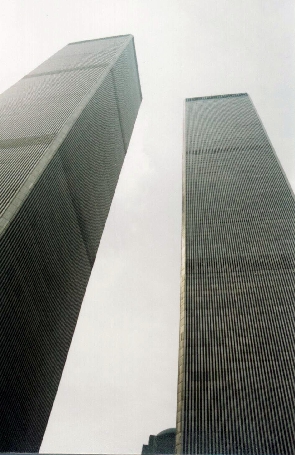 ``Yamasaki's commission to design the World Trade Center with the New
York firm of Emery Roth and Sons...house(s) anyone and anything
connected world trade. The program presented to Yamasaki, who was
selected over a dozen other American architects, was quite explicit:
twelve million square feet of floor area on a sixteen acre site, which
also had to accommodate new facilities for the Hudson tubes and subway
connections-all with a budget of under $500 million. The vast space
needs and limited site immediately implied a high-rise development
that...make(s) the adjacent drama of Manhattan's business tip seem
timid in comparison....
``Yamasaki's commission to design the World Trade Center with the New
York firm of Emery Roth and Sons...house(s) anyone and anything
connected world trade. The program presented to Yamasaki, who was
selected over a dozen other American architects, was quite explicit:
twelve million square feet of floor area on a sixteen acre site, which
also had to accommodate new facilities for the Hudson tubes and subway
connections-all with a budget of under $500 million. The vast space
needs and limited site immediately implied a high-rise development
that...make(s) the adjacent drama of Manhattan's business tip seem
timid in comparison....
``After studying more than one hundred schemes in model form, Yamasaki decided on a two-tower development to contain the nine million square feet of office space. One tower became unreasonable in size and unwieldy structurally, yet several towers became too approximate for their size and `looked too much like a housing project'; whereas two towers gave a reasonable office area on each floor, took advantage of the magnificent views, and allowed manageable structural system. The twin towers, with 110 floors rising 1,353 feet, ... (are) the tallest in the world. From observation decks at the top of the towers it...(is) possible to see 45 miles in every direction....One distinct advantage of the project's enormity is the architectural opportunity to advance the art of building. Yamasaki re-examined the skyscraper from the first principles, considering no ground so hallowed that it could not be questioned, especially in view of the potential of modern technology. The usual economic prohibition on `custom-made' was out, as virtually anything made for the Center would automatically become a stock item. `Economy is not in the sparseness of materials that we use,' said Yamasaki of his $350 million estimated cost, `but in the advancement of technology, which is the real challenge.'
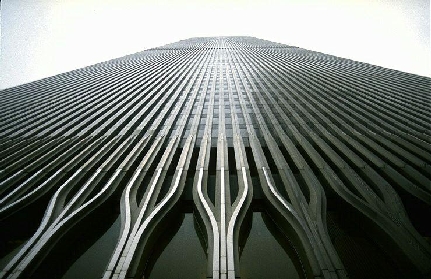
``The structural system, deriving from the I.B.M. Building in Seattle, is impressively simple. The 208-foot wide facade is, in effect, a prefabricated steel lattice, with columns on 39-inch centers acting as wind bracing to resist all overturning forces; the central core takes only the gravity loads of the building. A very light, economical structure results by keeping the wind bracing in the most efficient place, the outside surface of the building, thus not transferring the forces through the floor membrane to the core, as in most curtain-wall structures. Office spaces will have no interior columns. In the upper floors there is as much as 40,000 square feet of office space per floor. The floor construction is of prefabricated trussed steel, only 33 inches in depth, that spans the full 60 feet to the core, and also acts as a diaphragm to stiffen the outside wall against lateral buckling forces from wind-load pressures.
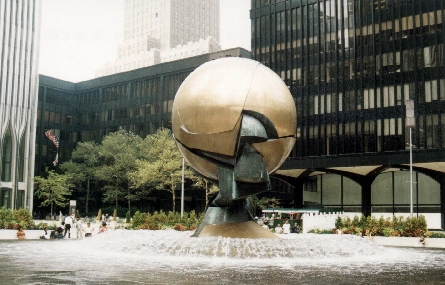 ``The other primary obstacle to be overcome in the skyscraper is the
elevator system, and Yamasaki has shown himself equally imaginative
here. A combination of express and local elevator banks, called a
skylobby system, it is particularly efficient because it requires
fewer elevator shafts-thus freeing approximately 75 percent of the
total floor area for occupancy; had a conventional elevator
arrangement been adopted, only approximately 50 percent would have
been available. The building has three vertical zones; express
elevators serve skylobbies at the forty-first and seventy-fourth
floors; from these, and from the plaza level, four banks of local
elevators carry passengers to each of the three zones.
``The other primary obstacle to be overcome in the skyscraper is the
elevator system, and Yamasaki has shown himself equally imaginative
here. A combination of express and local elevator banks, called a
skylobby system, it is particularly efficient because it requires
fewer elevator shafts-thus freeing approximately 75 percent of the
total floor area for occupancy; had a conventional elevator
arrangement been adopted, only approximately 50 percent would have
been available. The building has three vertical zones; express
elevators serve skylobbies at the forty-first and seventy-fourth
floors; from these, and from the plaza level, four banks of local
elevators carry passengers to each of the three zones.
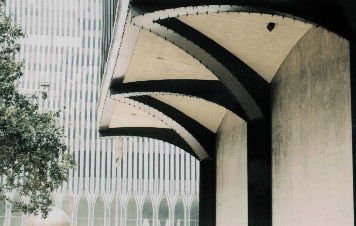 ``From the outset, Yamasaki believed that there should be an open plaza
from which one could appreciate the scale of the towers upon
approach. There is little or no sense of scale, for instance, standing
at the base of the Empire State Building. Yamasaki's plaza...(is)
sheltered from the river winds and contained by five-story buildings
which...house shops, exhibition pavilions and a 250-room
hotel.... `The World Trade Center should,' he said, `because of its
importance, become a living representation of man's belief in
humanity, his need for individual dignity, his belief in the
cooperation of men, and through this cooperation his ability to find
greatness.' ''
``From the outset, Yamasaki believed that there should be an open plaza
from which one could appreciate the scale of the towers upon
approach. There is little or no sense of scale, for instance, standing
at the base of the Empire State Building. Yamasaki's plaza...(is)
sheltered from the river winds and contained by five-story buildings
which...house shops, exhibition pavilions and a 250-room
hotel.... `The World Trade Center should,' he said, `because of its
importance, become a living representation of man's belief in
humanity, his need for individual dignity, his belief in the
cooperation of men, and through this cooperation his ability to find
greatness.' ''
Postscript: On February 26, 1993, a large bomb inside a van in the parking garage underneath the World Trade Center was detonated, killing six people and injuring 1042, in one of the worst acts of terrorism in U.S. history. The bomb was enormous (1200 pounds of urea nitrate), comparable in size to the Oklahoma City bomb, causing a tremendous release of energy, with not a single place to go because it was all closed in. While the explosion created an enormous crater where the parkade used to stand, the terrorists intention to topple the 110 storey building was thwarted by Yamasaki's engineering skill. Because of the load carrying role of the exterior steel columns, the foundation was unaffected by the blast.
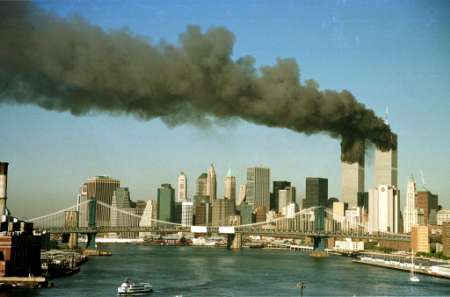
Final Postscript: September 11, 2001 is a date we will forever remember, as we helplessly watched two hijacked airliners deliberately crash into the twin towers. The intense heat from the large quantity of burning air-fuel eventually caused major structural failure of the central core, and the towers collapsed at approximately one hour and 1-3/4 hours later. The central cores imploded with remarkable speed (nearly free-fall conditions), with the steel lattice following the rest of the structure down. Our prayers go to the families of the thousands of casualties, including those of the hundreds of emergency workers trapped in the buildings as they collapsed.
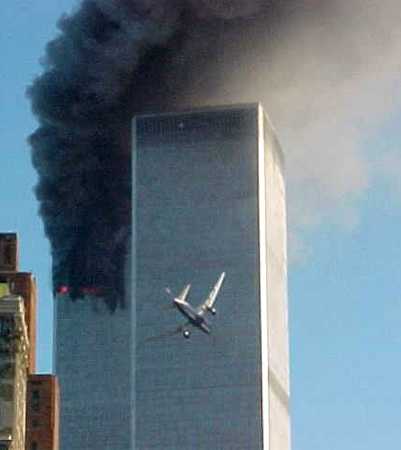
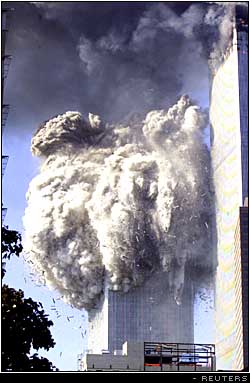
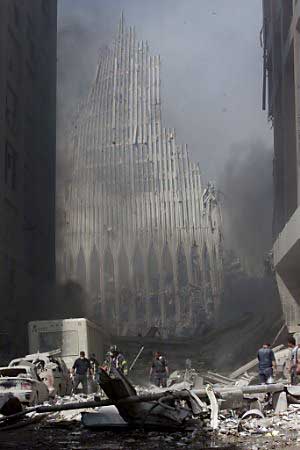
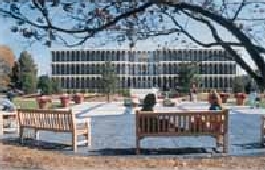
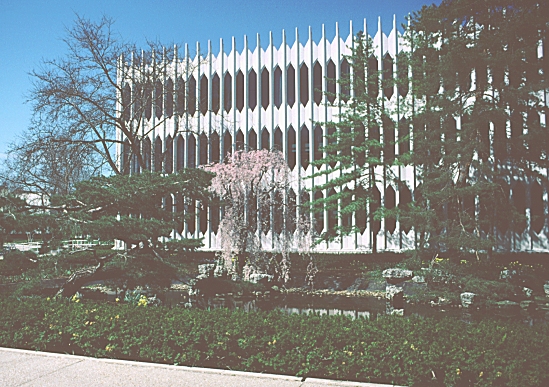
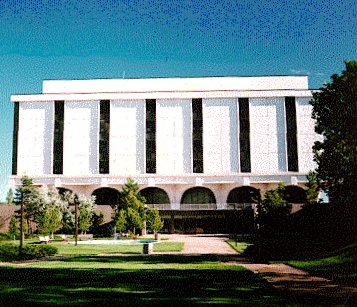
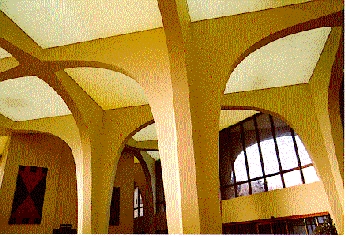
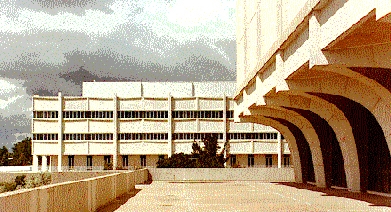 The concept for the buildings was that they would be located close
enough together that passage between them in the winter could be
provided through connecting corridors in the ``podium'' or first floor
of all buildings in the central instructional complex. Each podium
would be larger than the remaining floors of the buildings rising
above it, thereby creating the impression of separate buildings rising
from a common base. The buildings would be constructed around sunken,
landscaped courts which would be accessible visually and physically by
generous windows and doors from the corridors located along these
enclosing walls.
The concept for the buildings was that they would be located close
enough together that passage between them in the winter could be
provided through connecting corridors in the ``podium'' or first floor
of all buildings in the central instructional complex. Each podium
would be larger than the remaining floors of the buildings rising
above it, thereby creating the impression of separate buildings rising
from a common base. The buildings would be constructed around sunken,
landscaped courts which would be accessible visually and physically by
generous windows and doors from the corridors located along these
enclosing walls.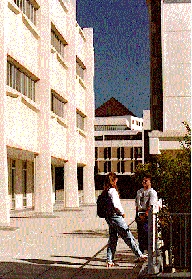 As part of his concept, Yamasaki proposed ``that different architects
be used for the various buildings and that each one be given as much
freedom as possible in the design of the buildings to sit on the
podium, including freedom in the choice of materials providing only
that the buildings be in architectural unity.'' The unifying concept
and central feature of the instructional core of the campus was the
podium. To achieve this, the level of the podium deck is constant,
and the cladding of the walls of all podia would be a common material,
which would provide a unified base for the buildings.
As part of his concept, Yamasaki proposed ``that different architects
be used for the various buildings and that each one be given as much
freedom as possible in the design of the buildings to sit on the
podium, including freedom in the choice of materials providing only
that the buildings be in architectural unity.'' The unifying concept
and central feature of the instructional core of the campus was the
podium. To achieve this, the level of the podium deck is constant,
and the cladding of the walls of all podia would be a common material,
which would provide a unified base for the buildings. Back to Garth's Hall of Architecture.
Back to Garth's Hall of Architecture.